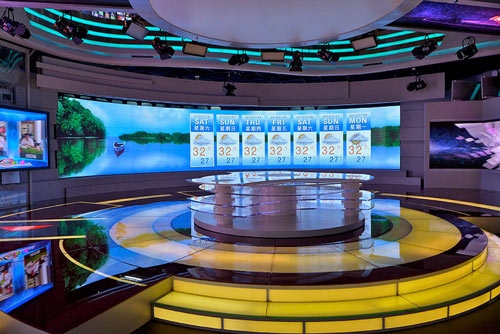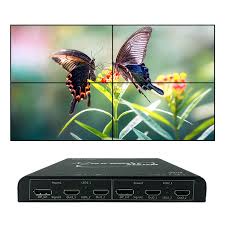
Video Wall Controller
Video Wall Controller In today's digital era, visual displays have become an integral part of various industries, from retail and entertainment to control rooms and corporate settings. Video walls, consisting of multiple displays arranged seamlessly to create a larger, cohesive image, have gained immense popularity for their ability to captivate and engage audiences.
What is Video Wall Controller:
Video Wall Controller managing and controlling these intricate setups efficiently can be a daunting task. This is where video wall controllers come into play, offering powerful solutions to simplify content management and enhance visual experiences. In this article, we will explore the functionalities and benefits of video wall controllers and their impact on different sectors.
Understanding Video Wall Controllers:
A video wall controller is a device that enables the control and management of multiple display screens within a video wall setup. It acts as the central hub, connecting various input sources to the individual displays, and orchestrates the content distribution across the entire video wall. By providing advanced processing capabilities, video wall controllers ensure that the visuals appear seamless, with accurate color reproduction and minimal latency.
Key Features and Functionalities:
- Display Configuration: Video wall controllers allow users to arrange and configure the layout of their video walls according to their specific requirements. This flexibility ensures that the content is displayed optimally, regardless of the screen orientation or the number of displays involved. Users can create stunning visual arrangements, such as mosaic layouts or multi-zone configurations, to convey their message effectively.
- Content Management: Efficient content management is a crucial aspect of any video wall setup. Video wall controllers offer powerful software interfaces that allow users to manage and control the content displayed on the video wall. With drag-and-drop functionality, scheduling options, and real-time updates, users can effortlessly switch between different content sources and deliver dynamic visuals.
- Source Integration: Video wall controllers seamlessly integrate with various input sources, including PCs, media players, cameras, and video conferencing systems. This versatility enables users to display a wide range of content, such as promotional videos, live feeds, presentations, and interactive applications. Advanced video wall controllers can handle multiple inputs simultaneously, ensuring a smooth and uninterrupted viewing experience.
- Video Processing: To ensure high-quality visuals, video wall controllers employ advanced video processing technologies. These technologies include pixel-level calibration, color correction, and image scaling. They ensure that the content is displayed accurately across all screens, eliminating inconsistencies and distortions that may arise due to differences in display technologies or aging effects.
Benefits across Industries:
- Retail: Video wall controllers revolutionize the retail sector by enabling captivating digital signage displays. Retailers can create immersive shopping experiences by showcasing product information, advertisements, and engaging content on large video walls. Video wall controllers allow them to update content in real time, ensuring that customers are always presented with the latest offers and promotions.
- Control Rooms: In mission-critical environments such as control rooms, video wall controllers play a vital role in displaying vital information from multiple sources simultaneously. Operators can monitor data, video feeds, and other critical content on large video walls, enhancing situational awareness and facilitating efficient decision-making.
- Events and Entertainment: Video wall controllers are extensively used in live events, concerts, and entertainment venues to create visually stunning backdrops, stage displays, and immersive experiences for the audience. With the ability to handle live feeds, playback pre-recorded content, and incorporate interactive elements, video wall controllers provide event organizers with unlimited creative possibilities.
Conclusion:
Video wall controllers have emerged as indispensable tools for managing and enhancing visual experiences across various industries. With their advanced features and functionalities, these controllers empower users to create captivating and dynamic displays while simplifying content management. From retail and control rooms to events and entertainment, video wall controllers have revolutionized the way organizations engage with their audiences. As technology continues to evolve, we can expect further advancements
Video Wall Controller How Its Work?
A video wall controller is a sophisticated device that serves as the central processing unit for a video wall setup. Its primary function is to manage and control the content displayed on multiple screens, creating a seamless and immersive visual experience. Let's dive into how a video wall controller works:
Hardware Setup:
To create a video wall, you need multiple displays or monitors arranged in a grid-like fashion. Each display is connected to the video wall controller, typically through HDMI or DisplayPort connections. The number of displays supported depends on the capabilities of the video wall controller.
Input Sources:
The video wall controller supports various input sources, such as PCs, media players, cameras, and video conferencing systems. These sources provide the content that will be displayed on the video wall. The video wall controller acts as a hub, receiving inputs from these sources and distributing them to the respective displays.

Video Processing:
Once the input sources are connected, the video wall controller processes the incoming video signals. It utilizes advanced video processing technologies to ensure uniformity across the displays. This includes pixel-level calibration, color correction, and image scaling to achieve consistent image quality and color accuracy.
Display Configuration:
The video wall controller allows users to configure the layout and arrangement of the displays. This configuration can be customized based on the desired visual effect or the content being displayed. Users can choose between different display arrangements, such as mosaic layouts or multi-zone configurations, to create a visually appealing video wall.
Content Management:
The video wall controller provides software interfaces or control panels that enable users to manage and control the content displayed on the video wall. Through an intuitive user interface, users can easily switch between different content sources, adjust settings, and schedule content playback. Some advanced video wall controllers offer real-time updates and the ability to create playlists for seamless transitions between different content types.
Real-Time Display:
Once the content is processed and configured, the video wall controller sends the video signals to the individual displays in real-time. It ensures synchronization among all the displays, minimizing latency and providing a seamless visual experience. The video wall controller continuously monitors and adjusts the display output to maintain consistency across the entire video wall.
Control and Monitoring:
Video wall controllers often come with built-in control and monitoring features. Users can remotely control the video wall controller, change settings, and monitor the status of the displays. This allows for easy troubleshooting and maintenance, ensuring optimal performance of the video wall setup.
Final Words:
In summary, a video wall controller acts as the central control unit for a video wall, processing and distributing content to multiple displays. It combines hardware and software components to deliver a seamless visual experience, providing flexibility in display configuration, content management, and real-time control. With their advanced functionalities, video wall controllers have become essential tools for creating captivating visual displays in various industries.


No comments yet